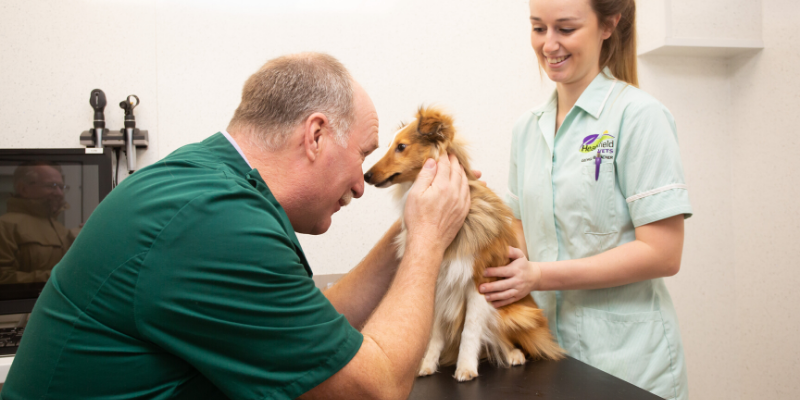
What are ear infections?
Ear infections are a growth of bacteria or yeast in the ear. They often have an underlying cause, such as allergies. Infections will generally affect the outer ear canal, this is called otitis externa. The infection can spread to the middle (otitis media) and inner ear (otitis interna).
What are the symptoms of an ear infection?
- Head shaking and tilting
- Pawing/scratching at their ear or rubbing their face on the ground
- Discharge from the ear
- A ‘yeasty’ odour
- A red, inflamed ear
- Whining due to pain and irritation
- Aural haematoma – a swollen blood blister caused by too much head shaking
In severe cases, untreated ear infections can lead to deafness, loss of balance and facial paralysis. It is worth remembering that even a minor ear infection can be incredibly painful – anyone who has had one themselves will be able to attest to this!
What causes ear infections?
- Certain breeds, such as beagles and spaniels are predisposed to ear infections due to their floppy ears but all dogs are susceptible.
- Allergies and food sensitivities
- Hypothyroidism
- Trauma to the ear canal
- Excess wax
- Overcleaning
- Excess moisture creating an excellent breeding ground for bacteria and yeast – dogs that swim often may need their ears cleaned and dried
- Foreign bodies
How are ear infections diagnosed?
Your vet will perform a full clinical exam, using specialist tools to look into the ear canal. In some cases they may take a swab to have analysed with an external lab in order to diagnose the specific infection we are dealing with and find which antibiotics will be best to fight the infection.
How are ear infections treated?
Treatment will be dependant on the diagnosis. Most ear infections will be treated with medicated ear drops; these will fight the specific infection, whether caused by bacteria or yeast, and will also reduce inflammation. Non-steroidal pain relief may also be given in severe cases. Your vet may also suggest regular cleaning of the ears during treatment and will show you the correct method of doing so. It is also important to treat the underlying issues that may be causing the infection such as skin allergies. In cases where a foreign body has caused an infection, these may have to be removed surgically.
As with all antibiotics, it is important that you finish the course as instructed by your veterinarian. It is also important that you return to see your vet for a re-examination even if you think the infection has ‘cleared up’. This needs to be confirmed by a full ear examination to ensure that the infection has cleared up all the way into the ear – sometimes it can look like the external ear is fine, while the bacteria/yeast is still in the internal ear and needs further treatment. All too often pets come back with recurrent ear infections as previous infections had not completely cleared although the symptoms had alleviated – this means the treatment process has to start again.
My pet had an ear infection a few months ago, now they have symptoms again, can’t I just get the same drops again?
While it is possible your pet is suffering with the exact same infection, there is a real risk that something else could be going on; a clinical examination is needed to ensure correct diagnosis and treatment. If a foreign body like a grass seed is causing irritation, then applying drops and not removing the offending seed will make the problem even worse. The vet will also need to check for things like ear mites, wax build up and the integrity of the ear drum. If the ear drum is not intact, certain medications could cause further damage, resulting in severe consequences for your pet.
How do I clean my pet’s ears?
Pets’ ear canals begin vertically and then switch to being horizontal (an L-shape) which can make them quite tricky to clean as not much of the canal is visible. Make sure to confirm with your vet that the cleaner you want to use if it has not been recommended by them and that the cleaning process is safe for your pet’s ear. In some cases, a cleaner would not be necessary as it is already incorporated into the treatment your vet has given, or it can interfere with the medication that has been applied, so it is always best to check first.
- Lift up the ear pinna (flap) to open the ear canal.
- Squeeze the veterinary approved or prescribed ear cleaner bottle to fill the ear canal.
- Massage gently at the base of the ear. If you are in the right place you will hear a squishing sound, this will encourage debris from the horizontal canal deep in the ear to come to the surface.
- Use a cotton ball or a cotton pad wrapped around your index finger to gently wipe the visible part of your dog’s ear canal and outer ear. Stop immediately if there is any yelping or discomfort.
- Repeat this process until no more debris comes to the surface.
Your pet will probably shake their head about during this process, so it is best to have them on a surface that you do not mind getting a little messy and wearing clothes that you don’t mind staining.
Call us on 01435 864422 if you think your pet may be showing signs of ear issues or book a health check via our online booking system.

